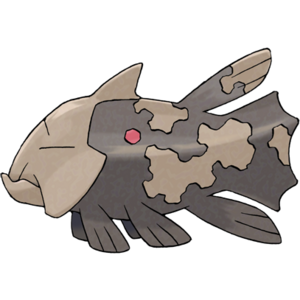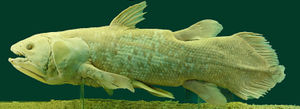On the Origin of Species: Relicanth
|
Relicanth is one of the Pokémon that reminds biology nerds like me just why we love the series. This particular Pokémon is a reference to one of the greatest zoological discoveries of the last hundred years: the coelacanth. And much like most great discoveries, the story began with a stroke of sheer good luck.
Seventy years ago, Marjorie Courtenay-Latimer was a curator at the Museum of East London in South Africa. Always on the lookout for new specimens, she had asked a number of local fishermen to let her know if they discovered anything unusual during their trawls. On the 22nd of December, 1938, she received a call from Captain Hendrik Goosen, just back from a trawl of the mouth of the Chalumna River. Amongst his catch was a particularly strange-looking fish, and when Latimer arrived to look at it, the specimen was unlike anything she could find in her books.
Many years later, Latimer recalled the moment she set eyes on the fish. "I picked away the layers of slime to reveal the most beautiful fish I had ever seen. It was five feet long, a pale, mauvy blue with faint flecks of whitish spots; it had an iridescent silver-blue-green sheen all over. It was covered in hard scales, and it had four limb-like fins and a strange little puppy dog tail. It was such a beautiful fish - more like a big china ornament - but I didn't know what it was."
Its appearance reminded her of descriptions of so-called ganoid fish, which were characterized by very thick, armor-like scales. But this seemed to be impossible, because the other notable characteristic of ganoid fish was that they were all extinct, only known by their fossils. In any case, it seemed that this fish, whatever it was, merited further study, and so she loaded it into a taxi and took it back to the museum.
Latimer's first instinct was to call on the expertise of her friend, Professor JLB Smith, a lecturer at Rhodes University in Grahamstown. Unfortunately, it turned out that the professor was away for Christmas, marking exam papers at his holiday home in Knysna. Her letter, containing a description and sketch of the fish, would not find him until eleven days later. In the meantime, Latimer was faced with the difficult task of preserving a large fish in the middle of the hot South African summer; her superior at the museum was unconvinced that it was anything special, and neither the local mortuary or cold-storage warehouse wanted the increasingly smelly carcass on their premises. In the absence of a speedy reply from Smith, Latimer realized her only option was to take the fish to a taxidermist.
Upon receiving the letter and viewing the illustration, Smith immediately realized that his friend had discovered a coelacanth: a member of a group of fish called the Crossopterygii. But, just like Latimer, he realized there was a problem with this conclusion: the Crossopterygii had been extinct since the end of the Cretaceous period. If he was to convince a sceptical scientific community that such an ancient fish still existed, he would need compelling proof. He sent an urgent telegram back to Latimer: "MOST IMPORTANT PRESERVE SKELETON AND GILLS = FISH DESCRIBED."
By this time, however, the innards had been discarded by the taxidermist. In the meantime, Latimer sent the professor one of the fish's scales, and this further convinced him that he was right in his identification: the fish was indeed a coelacanth. Smith eventually arrived at the museum in February, by which time the fish had (with some considerable difficulty) been preserved and mounted. Even without the innards, there was absolutely no doubt that the specimen was a fish believed to have died out sixty-five million years ago, earning it the description "living fossil". The species was named Latimeria chalumnae in recognition of Latimer and the river in which it was found, and the original coelacanth remains on display in East London to this day.
So, what is it that sets the coelacanth apart from other fish? Maybe the single most interesting feature is the fins, which are articulated and resemble short limbs. Indeed, the coelacanth is believed to be a cousin of the long-extinct Eusthenopteron, the fish whose descendants grew their fins into legs and migrated to the land, eventually evolving into amphibians, reptiles, birds and mammals. There's a healthy debate ongoing about whether or not coelacanths are our closest living relatives amongst the fish (the other strong candidates are the coelacanths' distant cousins, the lungfishes).
The term "living fossil", often applied to the coelacanth, can be a little misleading as it suggests that the creature has remained totally unchanged for millions of years. While the coelacanth still closely resembles its Cretaceous ancestors, it has been evolving over time just like any other animal, and possesses certain features its forebears lacked, such as the ability to give birth to live young instead of laying eggs. Until recently, Latimeria chalumnae was thought to be the only living species of coelacanth, limited perhaps just five hundred individuals in the area of ocean between South Africa and the Comoros: this small number of individuals, plus the fact that the Chalumna River is beyond the usual habitat of the fish, underlines just how fortunate Latimer was to encounter a coelacanth at all. But in 1997, a tourist in Indonesia noticed a coelacanth-like fish at a Sulawesi market. Remarkably, this turned out to be a member of a second coelacanth species, now known as Latimeria menadoensis, native to the waters around Indonesia. Unlike its better-known relative, the Indonesian coelacanth has a brownish color rather than blue, but the two are otherwise very similar.
With this story in mind, we can see clearly where Relicanth’s origins lie. The Pokédex mentions thick scales, limb-like fins and its status as a recently discovered "living fossil". Interestingly, Relicanth’s brown coloration seems to be based upon that of the lesser known L. menadoensis, but shiny Relicanth are bright blue, much like the dazzling L. chalumnae that Marjorie Courtenay-Latimer first laid eyes on back in 1938. While not everybody is as taken in by the coelacanth's arguable beauty as Latimer was, it can't be denied that this doggedly resilient fish represents an important moment in the history of zoology – and, indeed, in the development of life as we know it today.

